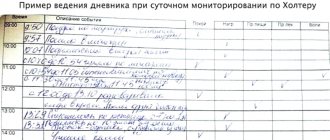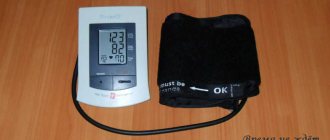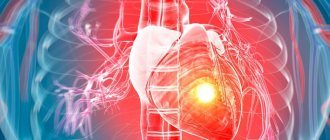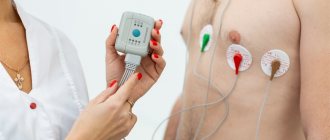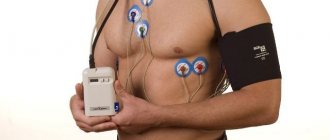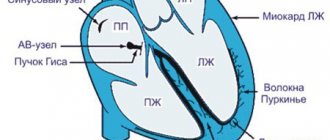Modern diagnostic technologies in medicine make it possible to more efficiently and effectively examine the entire body and find hidden diseases, congenital pathologies and neoplasms that appear throughout a person’s life. Daily ECG monitoring (Holter) or daily Holter recording is a diagnosis that consists of continuous recording of the electrical activity of the heart.
Features of daily ECG monitoring (Holter)
Holter ECG monitoring or Holter ECG appeared in medicine back in the mid-90s. The study consisted of monitoring heart function. The technique and equipment for the procedure were developed by American biophysicist Norman Holter.
Now the Holter ECG is considered one of the most reliable diagnostics for disturbances in the electrical activity of the heart throughout the day, in the conditions of the patient’s usual day and night. A special device is attached to the patient's body, it is called a portable recorder, which continuously records the ECG through electrodes that are placed on the patient's chest.
This diagnosis allows us to detect any cardiac dysfunction. Using the technique, it became possible to timely identify serious pathological changes that could not be detected during a routine examination by a cardiologist or when recording a routine ECG.
Content:
- Features of daily ECG monitoring (Holter)
- What is the difference between a regular ECG and a Holter ECG?
- When is Holter ECG prescribed?
- Types of Holter ECG monitoring
- Stages of preparation for the examination and features of its implementation
- Decoding the results
The patient carries the equipment in a special case. The study will not interfere with your usual lifestyle and will not cause any discomfort or discomfort. The patient should record any changes that occur in his health. The information is recorded on paper, indicating the exact time of the deterioration and the background against which this deterioration occurred.
The main advantages of diagnostics: a modern device records a huge amount of data, the analysis of which will make it possible to make a correct diagnosis; the device will detect any heart pathologies; thanks to the device, it is possible to promptly identify the daily number of rhythm disturbances, the type of rhythm and conduction disturbance, and ischemic signs; Conducting the study under familiar conditions will provide correct and reliable readings of heart function, since this eliminates additional stress.
How to remove a halter yourself at home
Tips for the patient when wearing Holter ECG (daily examination of ECG and blood pressure)
It is prohibited to: open the device cover and change batteries.
If you have a regular recorder and regular ECG electrodes, then you should avoid an aquatic environment: wash, go to the sauna, swim in the pool, sweat a lot... But you can wipe yourself with a damp towel, trying not to touch the cable and electrodes! During monitoring, you should not wear synthetic or woolen underwear (cotton only). While you sleep, you can place the monitor next to you (or under your pillow).
Allowed: Be sure to follow the doctor’s orders while wearing a 24-hour Holter ECG and blood pressure, no matter how absurd they may seem to you. Lead a normal life!
Required: Keep a diary with notes about your actions in everyday life!
For example, marking the time you take medications. There is no need to celebrate going to the toilet if you don’t feel anything special about your health.
I recommend checking the box “emotional physical stress” (sex) to identify the dangers of such stress! And be sure to follow all the doctor’s recommendations, indicating the time of their implementation.
For example: stress stair test with a number of steps, walking, running, lifting weights, etc. Everything you usually do in your life. The more honest you are in your diary, the more accurate your doctor's diagnosis of your heart condition will be.
For example, to detect atrial fibrillation, it is sometimes necessary to wear a Holter ECG for several days. Agree, it will not be possible to limit ordinary life in this case.
SO: let's list in more detail everything that is possible and what is not recommended to do while wearing a 24-hour ECG and BP recorder (Holter recording).
If you have sensitive skin, it is better to tell your doctor about this before the examination.
1. When using the device, it is better to have a doctor’s certificate about the installation of the device in order to avoid questions from police officers who may inadvertently mistake you for a terrorist.
2.What should I do if the ECG electrode comes off while changing clothes or while sleeping?
Ideally, you need to have 1-2 spare electrodes during the examination in order to re-glue them. But doctors don’t give spare electrodes with them! Mostly because you won’t be able to glue it correctly on your own.
Moreover, re-gluing the electrode to the same place does not lead to long-term results - the electrode is disposable. So what to do in this case? Nothing! Of course, the recording will not be complete, but the program will be able to decipher the ECG.
How? The doctor himself already knows this.
If all the electrodes and the cable along with them are “torn off,” then there is no choice. You need to go to the clinic for re-equipment. This often happens in the second part of the day or at night, and recording more than 12 hours may be enough for a doctor to diagnose your condition.
3. You noticed that the “Holter” stopped showing signs of life or beeped strangely…. A squeak or shutdown is due to premature discharge of the batteries. If you can find exactly the same ones, a replacement will save the day. Modern Holters have special batteries that cannot be replaced or recharged at home!
Advice: do nothing and continue wearing it, even if you are sure that it has turned off.
4. In addition to recording an ECG, some devices measure blood pressure at a specified time interval. This is uncomfortable, but necessary, be patient! When measuring blood pressure while moving, it is recommended to stop while the measurement is taking place. It is not necessary to sit down, just stand quietly.
5. Do not expose the device to shock, vibration, high or low
temperatures Do not use near aggressive agents (acids).
And most importantly, eliminate forced radio emissions from your life: EHF procedures and others.
Minimize the amount of time you spend using your cell phone; at a minimum, turn off cellular and data communications or place it on a nearby table! Talk on your cell phone as little and as briefly as possible.
This will eliminate false positives of the program when processing your record and FALSE DIAGNOSIS of a disease that you have never had! It will also eliminate noise from that section of the ECG recording where the doctor will diagnose your disease on the daily ECG recording. Take care of yourself!
Contraindications and side effects:
Holter monitoring is an absolutely painless procedure.
It has no contraindications. Can be used during pregnancy and breastfeeding, as well as in the elderly and children.
Does not cause side effects.
Source: https://dokvdom.ru/lechenie/kak-snyat-holter-samomu-doma.html
What is the difference between a regular ECG and a Holter ECG?
If we compare conventional electrocardiography with 24-hour monitoring, the first research method will be less informative and reliable. ECG is a recording of cardiac activity, which is carried out for 15-30 seconds in a state of complete rest. With its help, you can see the electrical processes in the heart, but only in a short period of time.
Standard electrocardiography will not be able to detect hidden cardiac pathologies that do not manifest clinically and are not recorded during recording by the device in resting states, or appear at an unspecified time during the day. As a result of a conventional study, it is impossible to see the functioning of the heart during eating, intense physical activity, sleep and rest.
Also, the correctness of the ECG results can be affected by the patient’s stressful state. This is due to the fact that during stress, phenomena will be present on the cardiogram that can be misinterpreted as pathology. Due to unreliable results, an incorrect diagnosis may be made, then treatment will be ineffective and even dangerous to human health.
Daily monitoring (Holter) will help identify disturbances in the functioning of the heart that are “transient” in nature (coronary heart disease, disturbances in heart rhythm and cardiac conduction). The duration of diagnosis depends on what abnormal and pathological phenomena the attending physician suspects.
To conduct a daily study, a portable recorder is used, which records all cardio readings. Modern devices can record not only cardiac indicators, but also blood pressure, respiratory indicators and others. This technique is allowed even for pregnant women and the elderly. ECG monitoring is indicated for all patients who have detected disturbances or abnormalities in the functioning of the heart.
Comments
No comments yet
Please log in to post a comment.
Thanks to modern technologies, a medical examination of a person allows us to identify and establish the most accurate changes occurring in the body.
The method of functional research includes Holter monitoring, which helps to monitor the electrocardiogram per day. ECG recordings are carried out continuously for two to three days, and they are then deciphered by a cardiologist.
The name of the Holter monitoring procedure comes from the name of the researcher who was the very first to use this device in practice (1961). An ECG holter is a portable recorder that is small in size; it records the functioning of the heart, recording information about its work throughout the day.
During this time, the device records the emerging features of the heart rhythm. The doctor may prescribe a diagnosis using a Holter monitor if a regular cardiogram provides insufficient information about the condition of the patient’s heart.
When is Holter ECG prescribed?
The Holter research method is recommended for people of all ages, including pregnant women. Fainting, dizziness, discomfort in the heart area, attacks of irregular heart function, palpitations, shortness of breath - all these symptoms are subject to daily Holter ECG monitoring.
In relation to the established nosology, this diagnostic procedure is indicated for the following diseases:
- heart defects;
- diseases of the endocrine system;
- obesity;
- acute or chronic heart failure;
- previous myocardial infarction;
- arterial hypertension;
- hypertension that is not amenable to therapeutic treatment.
It is also advisable to do a Holter ECG to monitor the operation of the pacemaker.
Existing indications for Holter monitoring
A Holter ECG performed by a doctor can be mainly prescribed to identify any heart rhythm disturbances that are quite difficult to detect during a regular electrocardiogram, that is, a short-term diagnosis.
Sometimes it happens that low-characteristic contractions specific to healthy heart muscles tend to manifest themselves only during times of strong emotional disturbances, possibly strong physical exertion.
In such cases, it is impossible to reflect such changes using a conventional electrocardiogram, and when performing Holter monitoring, the patient is able to lead the lifestyle to which he is accustomed, for example, perform various types of work, perform physical activity, and assume different body positions.
Holter diagnostics also allows you to identify any disturbances in the process of supplying the heart muscle with blood, especially the rise or fall of the ST segment during exercise.
Types of Holter ECG monitoring
Nowadays, a 24-hour examination is the best way to conduct a general diagnosis of the body and health status. The survey can be carried out in 2 ways: full-scale and fragmented.
The fragmentary method is used when a person has an arrhythmia. If the patient begins to feel discomfort, pain in the chest, or a general deterioration in health, he presses the button of the device and the recording of cardiac parameters begins.
A full-scale diagnostic method lasts for at least 1 day and maximum 1-2 weeks. An ordinary cardiogram will not provide as complete data as the method of the famous American biophysicist.
The doctor can assign several tasks to the patient, the results of which will be recorded by the device. For example, a patient needs to go up to the 7th floor, then go down. At this time, the recorder will record heart function indicators, which will determine the patient's health status.
The results of this diagnostic method
The nurse or cardiologist removes the Holter monitor from the patient, and the patient, in turn, provides completed records of physical activity; the symptoms shown require further interpretation.
The doctor, taking into account the results obtained, the doctor can make a diagnosis, if necessary, prescribe appropriate treatment, or when the origin of the detected disorders is not clear, the specialist will prescribe further examination to the patient.
For example, a patient will need to wear a device that records their heart rate for a short period of time. The patient can independently activate it; to do this, they only need to press a button during the period when cardiac symptoms of a serious nature appear.
Also, while determining changes in the process of blood supply to the heart muscle, the patient may be prescribed to do a stress electrocardiogram, and in some cases even perform angiography.
Stages of preparation for the examination and features of its implementation
In order for the technique to show reliable results, the patient should prepare for a procedure that will last for 24 hours or 3 or more days. Before the procedure, it is necessary to take a shower, because during the examination the patient must not remove the equipment or wet it with water. You should remove metal jewelry and accessories (watches, earrings, pendants), as metal negatively affects the accuracy of cardio readings. During the procedure, you need to wear comfortable clothes, preferably cotton.
For proper operation of the device, water should not be allowed to get on the equipment; contact of the equipment with other devices that create magnetic fields around them should be avoided. You must carry the recorder carefully so as not to damage its integrity: you must not drop or hit it.
The equipment consists of 2 parts - a stationary decoder and a recording device that takes readings. The electrodes are fixed to the skin.
A full-scale heart study is carried out while the patient leads his usual lifestyle, prepares food, runs, sleeps, eats, and rests. Everything that the patient does during the monitoring process is recorded in the diary. The time spent on a specific action is recorded. You can characterize your condition using three indicators: worsened, improved, or remained unchanged.
Rules and recommendations during a Holter ECG: first, you should not exhaust yourself with physical activity, because there is a risk that the electrodes will detach from the skin and the diagnostic results will be inaccurate: second, the patient should avoid stressful situations; third, it is undesirable to travel, fly on an airplane or go on attractions during the examination; fourth, the device should not be exposed to strong temperature changes; fifth, you should protect the recorder from moisture and water.
The patient should lie on his back so that the location of the electrodes is not disturbed. If your back hurts, you can turn over on your side, but at the same time monitor the operation of the device. This technique is considered safe; it does not cause complications or pathological changes. Cardiac registration should not be prescribed to people with high blood pressure, left ventricular diastolic dysfunction, organ dysfunction, acquired heart defects, asymptomatic myocardial ischemia, angina pectoris (chest discomfort).
Best materials of the month
- Coronaviruses: SARS-CoV-2 (COVID-19)
- Antibiotics for the prevention and treatment of COVID-19: how effective are they?
- The most common "office" diseases
- Does vodka kill coronavirus?
- How to stay alive on our roads?
Installation method for such a device
Before fixing the device on the patient’s body, the doctor will recommend taking a shower. This is explained by the fact that water should not get on the patient’s body for at least 24 hours, since the monitor cannot be removed.
The doctor attaches the electrodes to the patient’s chest, determines, and, if necessary, adjusts their correct position. Then the electrodes are connected to the wiring of the device that conducts the fixation. The device is attached to the patient’s body using appropriate straps.
The doctor instructs the patient and talks about the correctness of keeping a diary, which will subsequently allow him to correctly interpret the information that will be received from the device.
The patient will need to record periods of physical activity, sleep, rest and wakefulness, including the appearance of all symptoms: the occurrence of pain in the chest, the appearance of arrhythmia, tachycardia, etc., and the exact time should be indicated. Once the device is installed, the patient can begin to carry out their daily activities and lifestyle.
Holter monitoring does not cause any pain; the patient may feel some discomfort only while wearing the device. The patient is recommended to lie only on his back during sleep, as this will help to avoid displacement of the electrodes, which may interfere with the recording of indicators.
Archiving and submission of research.
1. In the patient log window, you must select the study that you will archive.
2. Click the right mouse button and in the menu that appears, select the line “export research to file”
3. To save the archive to a folder on your desktop, click the open folder icon.
4. In the address bar, select the path to save; the default folder is on the desktop. At the bottom, enter the file name with the patient's last name and click save.
5. Next, click the “start data export” button
6. After a message appears indicating that the export is complete, the program can be closed, and the saved archive must be uploaded to your personal account on our remote decryption service website.
Decrypted data
On the results sheet you will see the following indicators.
| Index | Norm |
| Average heart rate during the day | 60–100 beats per minute |
| Average heart rate at night and during daytime sleep | 41–81 beats/min |
| Daily graph of heart rate changes | Changes when changing activities |
| Number of supraventricular extrasystoles | Up to 960 supraventricular extrasystoles per day (up to 40 pcs. per hour) A slight excess of the norm (up to 1200 pcs. per day) does not pose a threat to life and health |
| Number of ventricular extrasystoles | The absolute norm is 0. The permissible quantity that does not threaten life and health is 200 pcs. per day |
| The duration of the QT and PQ intervals and the schedule of their changes. | Normal QT interval: 340–450 ms (0.34–0.45 s) for women and 340–430 ms for men PQ – 120–200 ms |
Note! The norms indicated in the table are averaged and do not take into account age and individual characteristics of the body. Ask your doctor about the norm for you personally.
Benefits of Holter monitoring at home
- High information content of the study. ECG registration is carried out during the patient’s normal activity, for 24-72 hours, which increases the accuracy of the results. Allows you to comprehensively assess blood pressure levels throughout the day.
- Comfort. To carry out diagnostics, compact portable equipment is fixed on the belt. The device does not cause discomfort to the patient. It is important that you do not need to change your lifestyle and operating conditions in order to undergo diagnostics.
- Qualified specialists. The results are interpreted by experienced functional diagnostic doctors who specialize in diagnosing cardiac diseases.
Memo for the subject
To achieve the most accurate result, you must follow the following rules:
- Use clothes made from natural fabrics. No metal elements or too loose clothing.
- Maintain the temperature of the device at average values
- Do not allow the device to come into contact with liquids
- Do not expose the device to vibrations
- Keep a distance from transformer boxes and similar structures
- Limited use of mobile phones and other similar devices.
- Do not subject the device to deformation
- Monitor the position of the electrodes on the body
- Determine the possibility of physical activity
Examination diary
An important point in obtaining high-quality research results is keeping a diary. It is imperative to record important moments during the day. For example:
- Taking medications
- Eating
- Dream
- Stress
- Activities
It is worth indicating the moments of change of activity, moments of ailments and unpleasant symptoms, as well as their exact time.

